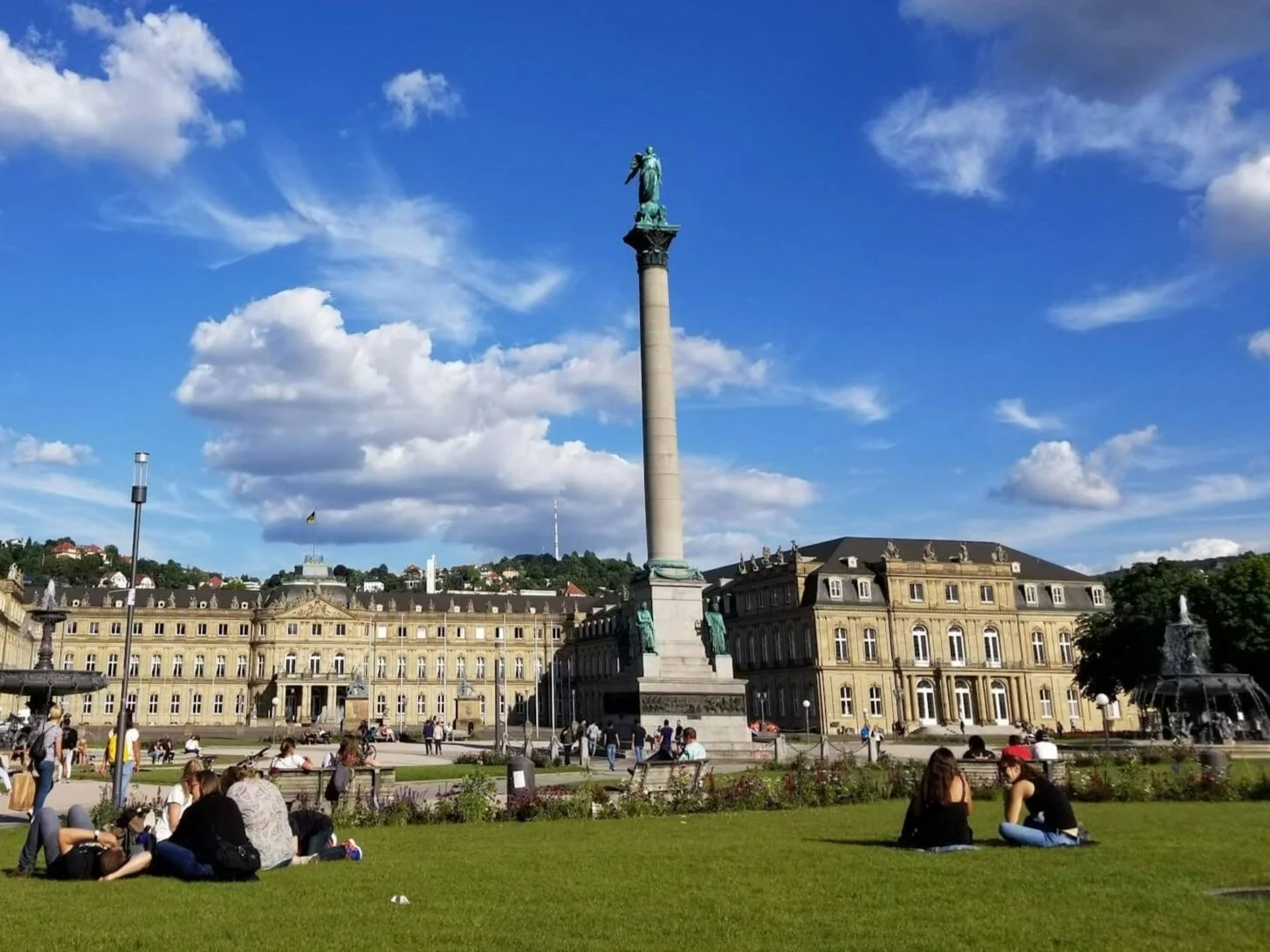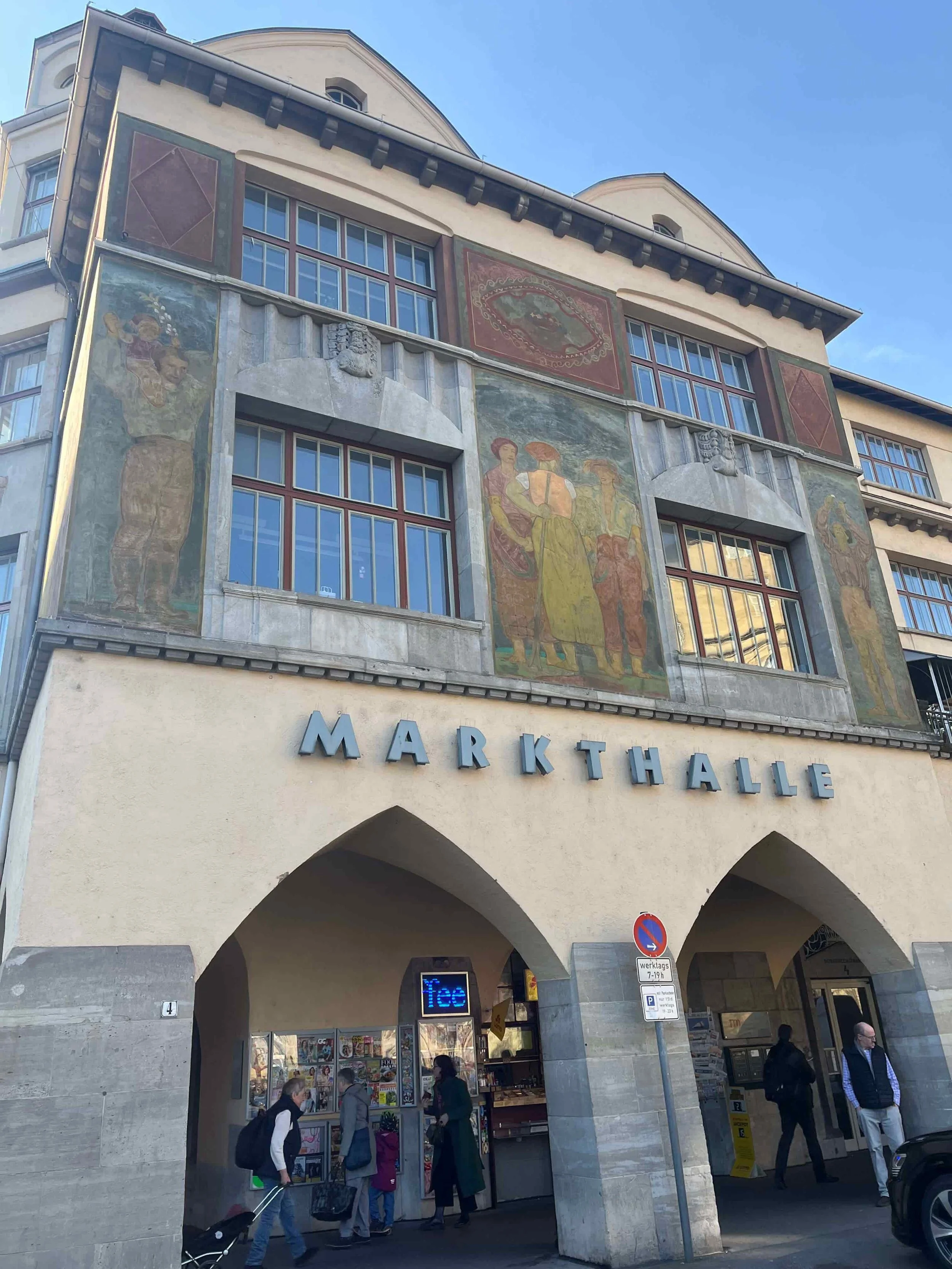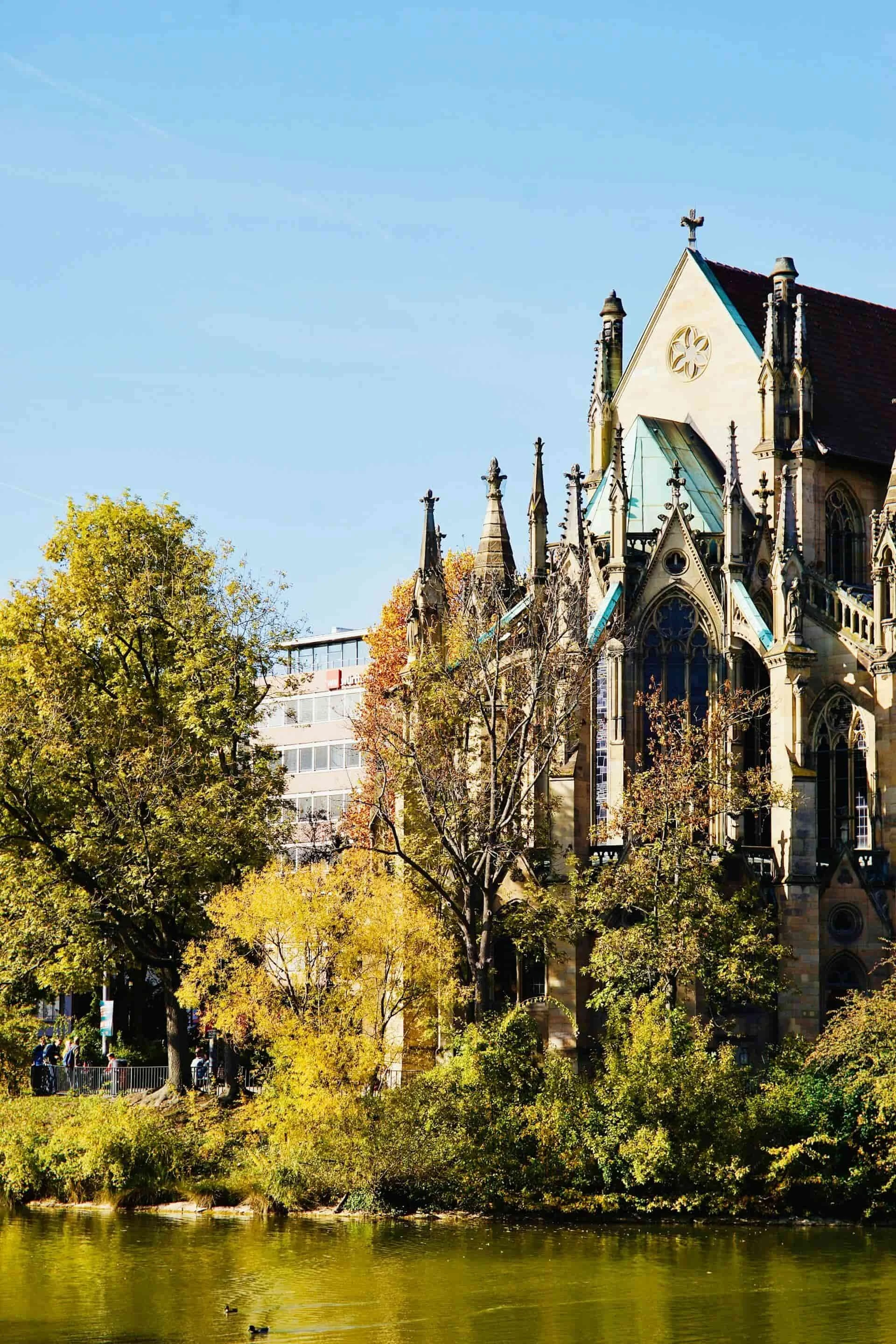What To Do In Stuttgart: How To Spend 1, 2, Or 3 Days in the Schwabenmetropole
Later in this post I share a few affiliate links. I may earn a commission if you click on them and make a purchase, at no cost to you. I really appreciate your support!
Stuttgart may not be the first city you decide to visit when planning a trip to Germany.
It’s not as avant-garde as Berlin, not as postcard-perfect as Rothenburg ob der Tauber.
BUT IS STUTTGART WORTH VISITING?
Absolutely — especially if you’re an architecture or design lover.
As the capital of the Swabian region in southern Germany, nicknamed the Schwabenmetropole, Stuttgart surprises in the best ways.
It’s a city of invention and innovation, known as the birthplace of the automobile and an early champion of Bauhaus design.
BUT IT’S ALSO FULL OF SMALL PLEASURES: ITS HILLSIDES ARE DOTTED WITH VINEYARDS AND ITS FOOD CULTURE IS HEARTY BUT REFINED.
Stuttgart is the kind of city that quietly delivers one “oh wow” moment after another — especially if you know where to look.
So whether you’re visiting to swoon over modernist architecture, take a deep dive into German engineering, or sip Swabian wine, this guide covers everything you need to plan the perfect Stuttgart trip.
Let’s go!
What To Do In Stuttgart: How To Spend 1, 2, Or 3 Days in the Schwabenmetropole
Top Experiences in Stuttgart
Planning your trip to Stuttgart?
Here are my FAVORITE experiences for a memorable visit to Stuttgart.
🔍 Discovery | Learn more about your destination
🤝 Connection | Meet locals, learn a craft, and trade stories
🎭 Performance | Immerse yourself in the local art and culture
🚌 Excursion | Explore nearby places of interest
🚀 Adventure | Seek thrill and excitement in the great outdoors
Curious how to find the best experiences no matter what destination you visit?
Download my Europe Experience Planner now!
How to Get Around Stuttgart
STUTTGART IS RELATIVELY EASY TO GET AROUND THANKS TO ITS RELIABLE PUBLIC TRANSPORTATION SYSTEM.
The S-Bahn and U-Bahn trains connect the city center with outer districts and nearby towns, while trams and buses fill in the gaps.
There is one small headache, and that’s the ongoing construction around Stuttgart Hauptbahnhof, the central station just steps from Schlossplatz.
The site is undergoing a major renovation that was supposed to be completed by 2025, but has been delayed until 2026.
IT’S NOT A DEALBREAKER FOR VISITING THE CITY BY ANY MEANS AS IT'S MOSTLY CONTAINED AROUND THE MAIN STATION.
Just be aware that it might take a moment to exit the Hauptbahnhof if you’re arriving by train.
Where to Stay in Stuttgart
Stuttgart is a surprisingly spread-out city, with neighborhoods that each offer a distinct vibe.
Where you stay can shape your experience, so here are a few areas to consider based on what they offer:
For Walkability: Stay in Stuttgart-Mitte, the compact city center near major sights, museums, and public transport.
For Natural Spa Lovers: Choose Bad Cannstatt, a historic district known for its mineral springs and relaxing thermal baths.
For Vineyard Views: Book in Degerloch or the South Hills, residential areas with stunning views and easy access to the funicular.
When to Visit Stuttgart
Stuttgart is at its best in spring and autumn, but its location in a valley can make it uncomfortable during the height of summer.
The best times to visit Stuttgart are spring and fall, when the weather is mild and the vineyards are at their most beautiful.
In September, the city hosts the Cannstatter Volksfest, one of Germany’s biggest beer festivals (and much less-touristy than Oktoberfest).
SPRING BRINGS BLOOMING PARKS AND SMALLER CROWDS.
Avoid August if possible, as many restaurants and shops close for summer holidays, and it can get uncomfortably hot.
The Best Things to Do in Stuttgart for Car Lovers
Stuttgart isn’t just home to two of the world’s most famous car museums; it’s the birthplace of the automobile itself.
While Karl Benz patented the first gasoline-powered car in Mannheim, it was through his company’s later merger with Stuttgart-based Daimler that the modern Mercedes-Benz brand was born.
THAT PARTNERSHIP HELPED ESTABLISH STUTTGART AS A DRIVING FORCE IN THE FLEDGLING AUTOMOTIVE INDUSTRY.
Today, the region remains a global leader in engineering and design.
Both Mercedes-Benz and Porsche are headquartered here, along with hundreds of suppliers, research hubs, and design firms tied to the automotive industry.
Visit the Mercedes-Benz Museum
The Mercedes-Benz Museum in Stuttgart, Germany.
My personal favorite: the 300 SL gullwing roadster.
Even if you're not a car enthusiast, this museum is worth a visit.
The Mercedes-Benz Museum is a spiraling architectural marvel that tells the story of the automobile, and how Stuttgart played a starring role.
Vintage models, race cars, and pop culture icons are all here.
My personal favorite is the pristine Mercedes-Benz 300 SL, a gullwing roadster from the late 1950s. 😍
Explore the Porsche Museum
THE PORSCHE MUSEUM IS MORE ABOUT STYLE AND PERFORMANCE THAN THE BRAND’S HISTORY.
The museum’s crisp, angular exterior mirrors the sleekness of what’s inside: a collection of legendary sports cars, concept vehicles, and racing icons.
You’ll see early prototypes, Le Mans champions, and road-ready models that defined automotive design in the 20th and 21st centuries.
It’s smaller than the Mercedes-Benz Museum, but that’s by design.
The Porsche Museum is more focused, more curated, and tailored to fans of precision and speed.
Where to See Stuttgart’s Standout Architecture
STUTTGART ISN’T KNOWN FOR MEDIEVAL CHARM OR HALF-TIMBERED HOUSES LIKE OTHER GERMAN TOWNS.
During World War II, more than 60% of the city was destroyed by Allied bombings, and most of its historic architecture was lost.
What replaced it was a mix of post-war reconstruction, modernist experimentation, and sleek contemporary design.
Today, Stuttgart’s architectural identity is shaped more by Bauhaus principles and innovative urban planning than fairy tale facades.
For architecture and design enthusiasts, that makes it one of the most fascinating cities in Germany to explore.
Tour the Weissenhof Estate
The Weissenhofsiedlung, built in 1927 for a housing exhibition, is one of the most important early modernist developments in Europe.
IT INCLUDES 21 BUILDINGS DESIGNED BY LEADING ARCHITECTS OF THE TIME.
The most famous of them was Le Corbusier, whose two surviving houses are now part of the UNESCO World Heritage Site.
Tour the on-site museum to gain insight into the project’s radical ideas about urban living and prefab construction.
See the New and Old Castles at Schlossplatz
The Neues Schloss in Stuttgart, today used for government offices.
Located in the heart of Stuttgart, Neues Schloss (“new castle”) is a late Baroque palace originally built for the Dukes of Württemberg in the 18th century.
Just next door, the Altes Schloss (“old castle”) dates back to the 10th century and now houses the Württemberg State Museum, filled with artifacts tracing the region’s royal and cultural history.
While the Neues Schloss today houses government offices and is rarely open to the public for tours, the state museum inside the Altes Schloss is worth a visit for history buffs.
Visit the Futuristic Stuttgart Library
The building's exterior is a sleek, cube-like structure.
The interior is a striking mix of book-lined walls and stark staircases.
Completed in 2011, the Stuttgart City Library is a bold architectural statement by Korean architect Eun Young Yi.
From the outside, it's a minimalist white cube with a glowing blue façade after dark.
Inside, the design unfolds as a vast, all-white atrium of open staircases and five stories of books.
IT’S EQUAL PARTS LIBRARY, SCULPTURE, AND PHOTOGRAPHY BACKDROP.
It’s free to enter and well worth a stop, even if you’re not checking out a book.
Stuttgart’s Must-Visit Museums and Cultural Sites
Stuttgart’s museum scene is more diverse than you might expect.
It includes world-class art collections, regional history, and global cultural exhibitions.
These museums offer a deeper look at both Stuttgart's local identity and its connections to the wider world.
Explore the Staatsgalerie Stuttgart
THE STAATSGALERIE STUTTGART IS ONE OF GERMANY’S PREMIER ART MUSEUMS.
The museum is split between two contrasting buildings: the original neoclassical structure, opened in 1843, and a bold postmodern addition designed by British architect James Stirling, completed in the 1980s.
The old wing houses classical works, including pieces by Rembrandt and Canaletto.
Stirling’s extension houses 20th-century and contemporary art, with standout works by German Expressionists and artists such as Picasso and Matisse.
Whether you’re there for the art or the design, don’t miss the museum’s rooftop terraces — they offer some of the best views in Stuttgart.
Visit the Haus der Geschichte
The Haus der Geschichte Baden-Württemberg (“House of History”) takes you through the political and cultural evolution of this southwestern German state.
The permanent exhibition begins in the 18th century and moves through the Napoleonic Wars, the formation of the German Empire, and both World Wars, culminating in the postwar era and German reunification.
What makes this museum so compelling is how it personalizes history: you’ll see original protest banners from the 1968 student movement, a Trabant parked in front of a Berlin Wall segment, and stories of local Swabians who influenced national politics.
It’s a rich museum that connects big events to everyday life, and makes room for humor and contradiction along the way.
Discover the Linden Museum
Stuttgart might seem like an unlikely home for one of Germany’s top ethnographic museums, but the Linden Museum traces its roots to the late 19th century, when Baden-Württemberg was a hub for academic exploration and global trade.
The museum was founded in 1911 as part of the city’s push to create a “world museum,” backed by merchants and scholars eager to showcase art and artifacts from beyond Europe.
Today, the Linden Museum holds impressive collections from East Asia, West Africa, the Islamic world, and the Americas.
YOU’LL FIND EVERYTHING FROM SAMURAI ARMOR AND JAPANESE WOODBLOCK PRINTS, TO RITUAL MASKS FROM CAMEROON AND FEATHER HEADDRESSES FROM AMAZONIAN TRIBES.
The North America exhibit highlights Indigenous nations through tools, clothing, and ceremonial objects from the Plains and Arctic.
And in the Islamic art section, look for intricately painted Persian miniatures, calligraphy panels, and Ottoman tiles.
This museum is a gem for travelers curious about the wider world — and a reminder of Stuttgart’s unexpected global reach.
Sample Traditional Swabian Food
Here’s how to get a true taste of Stuttgart’s culinary heritage.
Dine at a Cozy Weinstube
A Weinstube is a traditional wine tavern, and in Stuttgart, surrounded as it is by vineyard-covered hills, it’s the most local way to eat.
These small, often family-run spots serve hearty Swabian cuisine alongside regional wines like Trollinger, Lemberger, or Riesling, usually by the glass or half-liter.
Unlike the beer halls of Bavaria or northern Germany, where the focus is on large steins and communal revelry, Stuttgart’s Weinstuben offer a slightly quieter, more intimate vibe.
THEY'RE COZY, AFFORDABLE, AND COMPLETELY UNPRETENTIOUS.
If you want to eat like a local in Stuttgart, skipping a Weinstube would be a mistake.
Here are some of the best Weinstuben in Stuttgart:
Try Maultaschen and Kässpätzle
Swabia’s best-known dishes are Maultaschen, a kind of meat-filled ravioli, and Kässepätzle, or cheesy egg noodles topped with crispy onions, like German mac and cheese.
Here are some spots in Stuttgart renowned for their maultaschen:
Browse the Stuttgart Market Hall
Stuttgart’s Markethalle is inside an Art Nouveau building.
The Austern & Champagnerbar inside the Markthalle.
Not a fan of traditional German cuisine?
The Markthalle Stuttgart is a stunning Art Nouveau food hall where you can enjoy browse food stalls and an assortment of prepared cuisines.
When we visited, we stopped for an hour to enjoy oysters and champagne from one of the hall’s seafood vendors. 🥂
Enjoy Stuttgart’s Top Outdoor Spots
While Stuttgart is best known for its museums and design legacy, it also has plenty of green spaces and quirky outdoor corners that reflect the city’s personality.
From peaceful lakeside churches to flower-filled parks, here are a few outdoor spots that will add some fresh air to your visit:
Relax at the Feuersee – A small lake with a Gothic church backdrop, perfect for photos or a quiet coffee.
Ride the Historic Funicular – This vintage wood-paneled Standseilbahn links the city with Degerloch, offering great views on the way up.
Visit Killesberg Park – A beautifully landscaped park with rose gardens, a mini train, and a lookout tower for panoramic views.
Easy Day Trips from Stuttgart
Ludwigsburg Palace, nicknamed “the Versailles of Schwabia,” is a short thirty minute train ride outside of Stuttgart.
Stuttgart’s location in the heart of Baden-Württemberg makes it the perfect launchpad for day trips to nearby castles and medieval towns.
If you have extra time in your itinerary, here are a few standout spots that are easy to reach within an hour:
Explore Ludwigsburg Palace – Germany’s answer to Versailles, complete with sprawling gardens and a Baroque Christmas market in winter.
Visit Esslingen’s Old Town – A perfectly preserved medieval town known for its half-timbered houses and festive charm.
Take a Day Trip to Tübingen– Tübingen is a university town full of riverside cafés and charm.
Conclusion
Now that you’ve read about what to do in Stuttgart, the only remaining question is how many days do you really need to explore the Schwabenmetropole?
If you’re just here for the car museums, and you’re efficient with your time, then a one-day visit could be enough.
Both Mercedes-Benz and Porsche Museums are doable in a single day with time to spare for dinner at a local Weinstube.
BUT IF YOU WANT TO EXPERIENCE STUTTGART BEYOND THE CARS, YOU’LL NEED 2 TO 3 DAYS.
That gives you time to dive into the architecture at the Weissenhof Estate, explore major museums like the Staatsgalerie and Haus der Geschichte, and maybe even squeeze in a day trip to Ludwigsburg or Esslingen.
Stuttgart rewards a slower pace, and while it may not impress you in the first five minutes, it’s likely to stay with you long after you leave.
PLANNING A VACATION?
When you book through my links, you help support the site — at no extra cost to you.
Thanks for being a part of the Notes From Here journey! ❤️
💃 Book Tours and Experiences with Viator
🛎️ Find Hotels with Booking.com
🚗 Find a Rental Car with Discover Cars
🚅 Book a Train with RailEurope
🛡️ Get Travel Insurance with SafetyWing
🎩 Arrange Private Transfers with DayTrip
🚌 Book a Bus or Ferry with Omio
YOU’LL ALSO LOVE…















